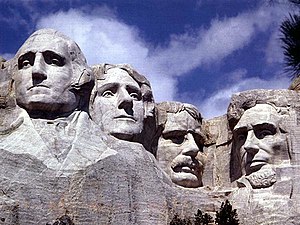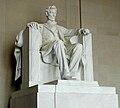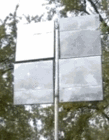
The Mount Rushmore National Memorial is a national memorial centered on a colossal sculpture carved into the granite face of Mount Rushmore in the Black Hills near Keystone, South Dakota, United States. Sculptor Gutzon Borglum designed the sculpture, called Shrine of Democracy, and oversaw the project's execution from 1927 to 1941 with the help of his son, Lincoln Borglum. The sculpture features the 60-foot-tall (18 m) heads of four United States presidents: George Washington (1732–1799), Thomas Jefferson (1743–1826), Theodore Roosevelt (1858–1919) and Abraham Lincoln (1809–1865). Mount Rushmore attracts more than two million visitors annually. The four presidents were chosen to represent the nation's birth, growth, development and preservation, respectively. The memorial park covers 1,278 acres and the mountain's elevation is 5,725 feet (1,745 m) above sea level.

John Gutzon de la Mothe Borglum was an American sculptor best known for his work on Mount Rushmore. He is also associated with various other public works of art across the U.S., including Stone Mountain in Georgia, the statue of Union General Philip Sheridan in Washington, D.C., as well as a bust of Abraham Lincoln which was exhibited in the White House by Theodore Roosevelt and which is now held in the United States Capitol crypt in Washington, D.C.

Augustus Saint-Gaudens was an American sculptor of the Beaux-Arts generation who embodied the ideals of the American Renaissance. From an Irish-French family, Saint-Gaudens was raised in New York City. He traveled to Europe for further training and artistic study. After he returned to New York, he achieved major critical success for his monuments commemorating heroes of the American Civil War, many of which still stand. Saint-Gaudens created works such as the Robert Gould Shaw Memorial on Boston Common, Abraham Lincoln: The Man, and grand equestrian monuments to Civil War generals: General John Logan Memorial in Chicago's Grant Park and William Tecumseh Sherman at the corner of New York's Central Park. In addition, he created the popular historicist representation of The Puritan.

Adolph Alexander Weinman was a German-born American sculptor and architectural sculptor.
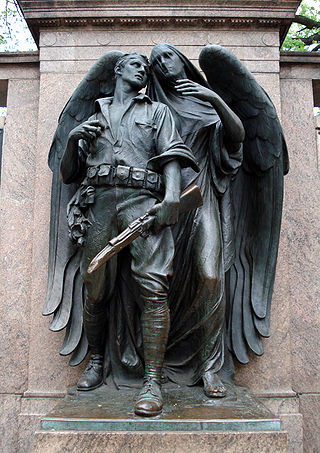
Henry Augustus Lukeman was an American sculptor, specializing in historical monuments. Noted among his works are the World War I monument in Prospect Park, Brooklyn, the Kit Carson Monument in Trinidad, Colorado and the Stone Mountain Confederate Memorial in Georgia.
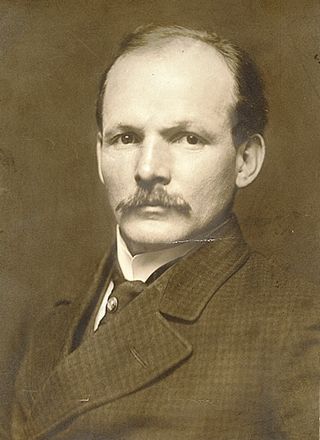
Solon Hannibal de la Mothe Borglum was an American sculptor. He is most noted for his depiction of frontier life, and especially his experience with cowboys and native Americans.

Abraham Lincoln: The Man is a larger-than-life size 12-foot (3.7 m) bronze statue of Abraham Lincoln, the 16th president of the United States. The original statue is in Lincoln Park in Chicago, and later re-castings of the statue have been given as diplomatic gifts from the United States to the United Kingdom, and to Mexico.
James Lincoln de la Mothe Borglum was an American sculptor, photographer, author and engineer; he was best known for overseeing the completion of the Mount Rushmore after the death of the project's leader, his father, Gutzon Borglum, in 1941. One of his best-known works, a bust of his father, is on display outside the Lincoln Borglum Visitors Center at Mount Rushmore.

John Sherrill Houser was an American painter and sculptor.

The Crazy Horse Memorial is a mountain monument under construction on privately held land in the Black Hills, in Custer County, South Dakota, United States. It will depict the Oglala Lakota warrior Crazy Horse, riding a horse and pointing to his tribal land. The memorial was commissioned by Henry Standing Bear, a Lakota elder, to be sculpted by Korczak Ziolkowski. It is operated by the Crazy Horse Memorial Foundation, a nonprofit organization.

Korczak Ziolkowski was the Polish-American designer and sculptor of the Crazy Horse Memorial.
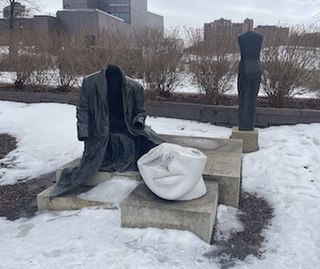
Judith Shea is an American sculptor and artist, born in Philadelphia, Pennsylvania, in 1948. She received a degree in fashion design at Parsons School of Design in 1969 and a BFA in 1975. This dual education formed the basis for her figure based works. Her career has three distinct phases: The use of cloth and clothing forms from 1974 to 1981; Hollow cast metal clothing-figure forms from 1982 until 1991; and carved full-figure statues made of wood, cloth, clay, foam and hair beginning in 1990 to present.

Wars of America is a colossal bronze sculpture by Mount Rushmore sculptor Gutzon Borglum and his assistant Luigi Del Bianco containing "forty-two humans and two horses", located in Military Park in Newark, New Jersey. The sculpture sets on a base of granite from Stone Mountain.

General Philip Sheridan is a bronze sculpture that honors Civil War general Philip Sheridan. The monument was sculpted by Gutzon Borglum, best known for his design of Mount Rushmore. Dedicated in 1908, dignitaries in attendance at the unveiling ceremony included President Theodore Roosevelt, members of the President's cabinet, high-ranking military officers and veterans from the Civil War and Spanish–American War. The equestrian statue is located in the center of Sheridan Circle in the Sheridan-Kalorama neighborhood of Washington, D.C. The bronze statue, surrounded by a plaza and park, is one of eighteen Civil War monuments in Washington, D.C., which were collectively listed on the National Register of Historic Places in 1978. The sculpture and surrounding park are owned and maintained by the National Park Service, a federal agency of the Interior Department.

Death and the Sculptor, also known as the Milmore Monument and The Angel of Death and the Young Sculptor is a sculpture in bronze, and one of the most important and influential works of art created by sculptor Daniel Chester French. The work was commissioned to mark the grave in Forest Hills Cemetery in Jamaica Plain, Boston, Massachusetts, of the brothers Joseph (1841–1886), James and Martin Milmore (1844–1883). It has two figures effectively in the round, linked to a background relief behind them. The right-hand figure represents a sculptor, whose hand holding a chisel is gently restrained by the fingers of the left-hand figure, representing Death, here shown as a winged female.
Ruth Carolyn Ziolkowski was an American executive and CEO of the Crazy Horse Memorial, a South Dakota monument dedicated to Crazy Horse which was designed by her late husband, Korczak Ziolkowski.

First Landing Party of the Founders of Newark is a marble monument with bas-relief and inscription by sculptor Gutzon Borglum (1867–1941) near the New Jersey Performing Arts Center in Newark, New Jersey. It was dedicated in 1916. It was listed on the New Jersey Register of Historic Places in 1990 and the National Register of Historic Places in 1994 as part of the Public Sculpture in Newark, New Jersey Multiple Property Submission.
